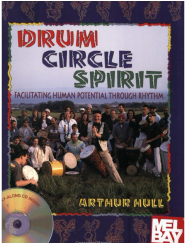1. Drum Circle Spirit by Arthur Hull
I mentioned Drum Circle Spirit in my last post about improving your drumming skills since it approaches rhythm from a compelling viewpoint: somebody who wants to include all students in music making whatever the cost. This is not a technical read and is the easiest one on the list.
I mentioned Drum Circle Spirit in my last post about improving your drumming skills since it approaches rhythm from a compelling viewpoint: somebody who wants to include all students in music making whatever the cost. This is not a technical read and is the easiest one on the list.
Hull describes drumming activities that have comfortable learning curves for both the teacher and the student. The drum circle facilitation skills, such as cueing, are immediately adaptable to all sorts of group drumming whether it’s bucket drumming, hand drums, or even barred instruments. But the most notable content are the stories about creating inclusive environments for students of all ages, abilities, and interests. That is something that all K-12 music teachers can benefit from.
2. Syncopation by Ted Reed
2. Syncopation by Ted Reed
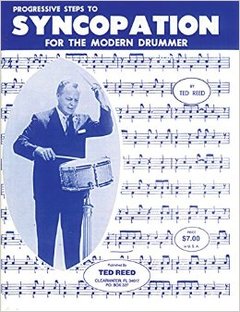
Syncopation is a classic drum text that contains almost no directions. Instead it serves as an encyclopedia of rhythms. Starting with quarter notes and eighth notes and progressing through all sorts of rests, syncopations, and triplets, this book can serve as a rhythmic ‘gut check’ for teachers who want to improve their sense of rhythmic feeling (see #3 below).
Take the time to turn on a metronome and play through the rhythms until they feel comfortable and really start to groove. That experience would no doubt improve your rhythm teaching come this fall. Another similar text is Louis Bellson’s Modern Reading Text in 4/4 for All Instruments.
3. A Sound Approach to Teaching Instrumentalists (2nd Ed.) by Stanley Schleuter
Take the time to turn on a metronome and play through the rhythms until they feel comfortable and really start to groove. That experience would no doubt improve your rhythm teaching come this fall. Another similar text is Louis Bellson’s Modern Reading Text in 4/4 for All Instruments.
3. A Sound Approach to Teaching Instrumentalists (2nd Ed.) by Stanley Schleuter
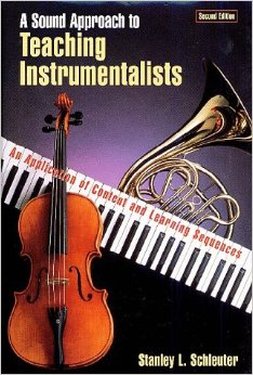
o book better describes how to teach students to play instruments. Chapter 4 alone, “Teaching Rhythmic Feeling,” is well worth picking up a copy.
In just a few short pages, Schleuter describes what initial reading content to include, how to build a rhythm pattern vocabulary in students, rhythm pattern teaching techniques and more.
But the most notable take away is his definition and description of rhythmic feeling. This is Schleuter’s term which succinctly describes all of the cognitive and physical skills that are involved with the comprehension and performance of rhythm. The blending of the practical and theoretical had cemented this book as the foundation of how I teach rhythm.
In just a few short pages, Schleuter describes what initial reading content to include, how to build a rhythm pattern vocabulary in students, rhythm pattern teaching techniques and more.
But the most notable take away is his definition and description of rhythmic feeling. This is Schleuter’s term which succinctly describes all of the cognitive and physical skills that are involved with the comprehension and performance of rhythm. The blending of the practical and theoretical had cemented this book as the foundation of how I teach rhythm.
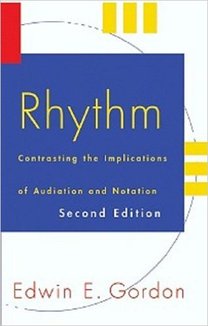
Catchy title right? Full disclosure: While I am a proud practitioner of Music Learning Theory, this book should fascinate any music teacher as Gordon challenges conventional approaches to understanding and teaching rhythm.
I remember reading this book for the first time and marveling as it described all of the problems that I had performing and teaching rhythm. Of particular interest is his chapter of rhythm solfege and the taxonomy of rhythm patterns based on difficulty (you might be surprised at what he considers as some of the most difficult rhythms). A deeper read than the first three
books above, but well worth the effort.
5. Hearing in Time: Psychological Aspects of Musical Meter by Justin London
I remember reading this book for the first time and marveling as it described all of the problems that I had performing and teaching rhythm. Of particular interest is his chapter of rhythm solfege and the taxonomy of rhythm patterns based on difficulty (you might be surprised at what he considers as some of the most difficult rhythms). A deeper read than the first three
books above, but well worth the effort.
5. Hearing in Time: Psychological Aspects of Musical Meter by Justin London
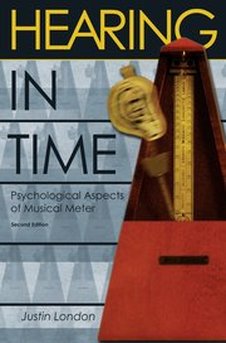
Neuroscience and music are popular topics these days and London’s book takes square aim at one of the enduring questions facing researchers and teachers alike: “What is musical meter and how to humans perceive it?”
The book covers complex topics such as non-isochronous meters, metric well-formedness, and includes a fascinating chapter on metric flux in Beethoven’s Fifth symphony. London covers these topics with many notated examples and includes non-western examples in his discussion.
While this is the most challenging read on this list, you can tell that London approaches music as a performer and listener as well as a theorist. Hearing in Time explores the fundamental cognitive and perceptual issues that our students experience in and out of our classrooms and therefore is an important book for music teachers.
The book covers complex topics such as non-isochronous meters, metric well-formedness, and includes a fascinating chapter on metric flux in Beethoven’s Fifth symphony. London covers these topics with many notated examples and includes non-western examples in his discussion.
While this is the most challenging read on this list, you can tell that London approaches music as a performer and listener as well as a theorist. Hearing in Time explores the fundamental cognitive and perceptual issues that our students experience in and out of our classrooms and therefore is an important book for music teachers.
